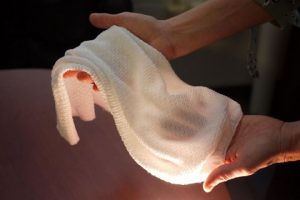When the temperature drops, we layer up. It’s the natural thing to do—until now. According to ScienceDaily, researchers at the University of Maryland have engineered a new fabric that can automatically change its properties to trap or release heat depending on external conditions.
The textile, made from synthetic yarn with a carbon nanotube coating, is activated by temperature and humidity: making it the first of its kind. When conditions are warm and moist, such as those near a sweating body, the fabric allows heat to pass through. When conditions become cooler and drier, the fabric reduces the heat that escapes. Acting like blinds, the individual strands of yarn open and close to transmit or block heat.
The reaction is almost instant: before people realize they’re getting hot, the garment could already be cooling them down and vice versa.
“The human body is a perfect radiator. It gives off heat quickly,” said Min Ouyang, a professor of physics at the University of Maryland and the paper’s other corresponding author. “For all of history, the only way to regulate the radiator has been to take clothes off or put clothes on. But this fabric is a true bidirectional regulator.”
The research team says more work is needed before the fabric can be commercialized. However, materials used for the base fiber are readily available, and the carbon coating can be easily added during the standard dyeing process.
“I think it’s very exciting to be able to apply this gating phenomenon to the development of a textile that has the ability to improve the functionality of clothing and other fabrics,” said Ouyang.
The Society is a proud supporter of researchers in the electrochemical, solid state science, and technology fields. As part of this support, ECS of scientists, engineers, and researchers a number of awards to encourage and fund innovation in the sciences.
In 2006, ECS established the Nanocarbons Division Richard E. Smalley Research Award to encourage research in fullerenes, nanotubes, and carbon nanostructures. The award offers recipients a scroll, a $1,000 prize, and assistance up to a maximum of $1,500 to facilitate meeting attendance at which the award is to be presented.
Nomination Deadline: September 1, even years
In addition, in 2018, ECS established the Nanocarbons Division Robert C. Haddon Research Award to recognize individuals who’ve made outstanding contributions to the understanding and applications of carbon materials. The award too offers receipients a scroll, a $1,000 prize, and assistance up to a maximum of $1,500 to facilitate meeting attendance at which the award is to be presented.
Nomination Deadline: September 1, odd years
Learn more on the Society’s many honors and awards programs here.


